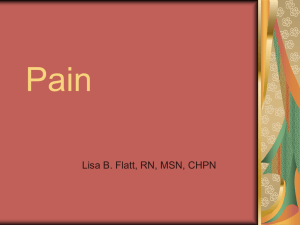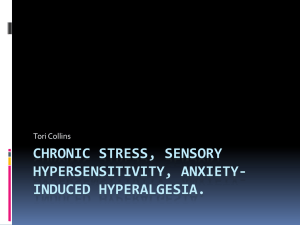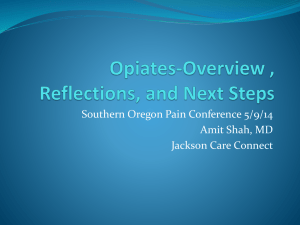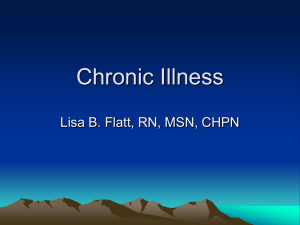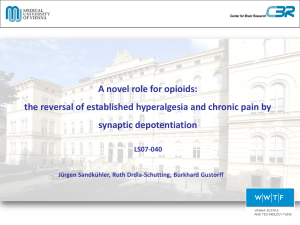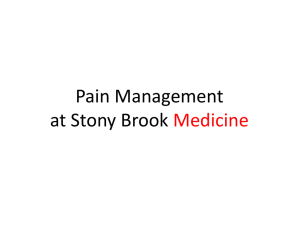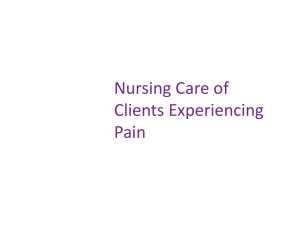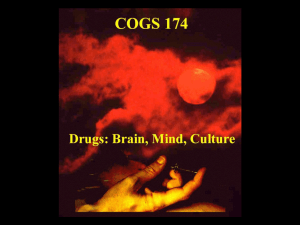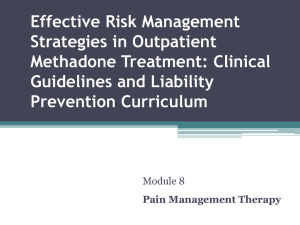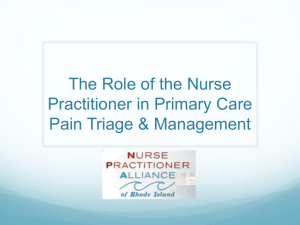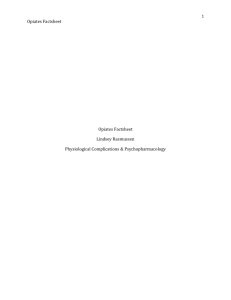But Doc I Really Hurt - Gregory L. Jones, MD
advertisement
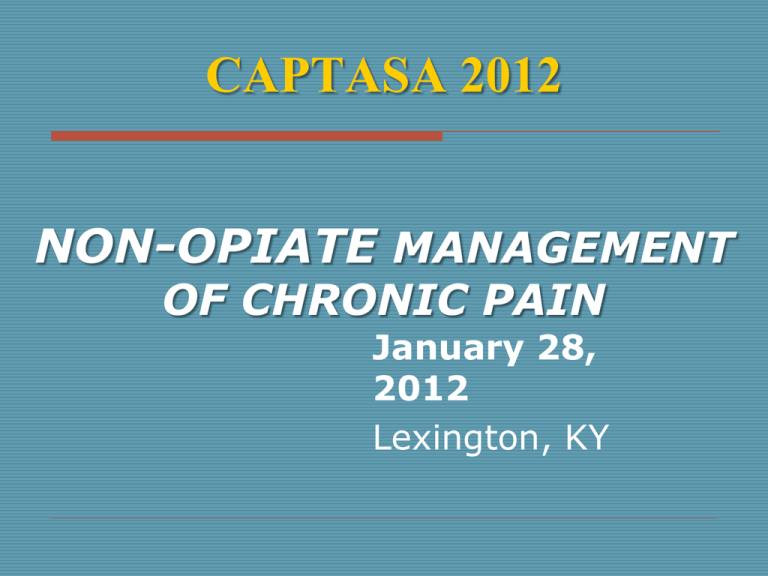
CAPTASA 2012 NON-OPIATE MANAGEMENT OF CHRONIC PAIN January 28, 2012 Lexington, KY "But I Really Hurt " Intervention Where Chronic Pain is an Issue The Face of Pain It's getting to the point Where I'm no fun anymore… I am sorry. Crosby Stills Nash & Young Suite: Judy Blue Eyes “Dare to be naïve.” R. Buckminster Fuller Willingway Four Truths The total Cause of Alcoholism and Drug Addiction is Unknown. Alcoholism is at least in part a Chemical illness. There is a relationship between Alcoholism and Addiction to other drugs. Alcoholism is an illness of the total person (body, mind and spirit). www.willingway.com Learning Objectives: Explain the difference between Acute and Chronic Pain Summarize Opiate Induced Hyperalgesia Review Non-Opiate options Case studies Decisions aught to be based on information Opiates are highly addictive Recovery from any addictive substance is likely only if all addictive substances are avoided There are alternatives for Chronic pain Pain Management vs. Patient Management Acute Pain Chronic Pain The Patient with the Pain Sir William Osler “It is more important to know what kind of patient has a disease… than what kind of disease a patient has” Alcoholics Anonymous, page 64 from “How It Works” …for we have been not only mentally and physically ill, we have been spiritually sick. When the spiritual malady is overcome, we straighten out mentally and physically. The International Association for the Study of Pain "an unpleasant sensory and emotional experience associated with actual or potential tissue damage…“ Pain is subjective in nature and is defined by the person experiencing it Understanding of chronic pain now includes the impact that the mind has in processing and interpreting pain signals. Brain in Pain Acute vs. Chronic Pain WHO 3-step ladder 3 severe Morphine 2 moderate Hydromorphone Methadone A/Codeine 1 mild ASA Acetaminophen NSAIDs A/Hydrocodone A/Oxycodone A/Dihydrocodeine Levorphanol Fentanyl Oxycodone ± procedures JCAHO Pain Standards (2001) Include pain treatment in patient bill of rights. Screen all patients for pain on admission and regularly thereafter. Ensure competency of staff and physicians in pain assessment and management. Institutionalization of Pain Opioid Prescriptions Soar Between 1999 and 2002: Oxycodone Rx’s increased 50% to 29 million Fentanyl Rx’s increased 150% to 4.6 million Morphine Rx’s increased 60% to 3.8 million Opioid Prescriptions Soar In 2004, the United States used 99% of the world’s supply of hydrocodone Between 1999 and 2002, in the United States, there has been a 91.2% increase in deaths due to opioid overdose. New Non-medical Users of Pain Relievers 1965-2002 Thousands of New Users 3,000 2,500 All Ages 2,000 1,500 Over 18 Under 18 1,000 500 0 1965 1970 1975 1980 1985 1990 Source: 2003 NSDUH, SAMHSA 1995 2000 Growth of Pain Clinics March 2011 $634.5M settlement for OxyContin maker The firm and the current and former executives, including the CEO, pleaded guilty in U.S. District Court…to a felony charge of misleading doctors and consumers about the drug's risks of abuse and addiction… CNN Risk to Society “The diversion of prescription opioids has become a major public health hazard” -Paulozzi, et.al., 2006 ED visits for nonmedical use of opioid analgesics increased 111% from 2004-2008 Population Health Management 2009;issue 12 (Pt’s in Pain clinic) Nearly 40% of all pt’s had no opiates on UDS 11% tested positive for illicit drugs Unprescribed opiates in 29% of samples Dr. Leider “startling results” Jefferson School of Population Health and Ameritox Managed Care concerns with Chronic Opiate use Chronic opiate users cost/yr. $23,049 vs. $4975 for nonusers Out-pt. visits/yr. average of 24.7 vs. 11.7 ER visits 4.1 vs. 2.6 Hospitalizations 1.0 vs. 0.4 Leider et al. AmJofMC Jan 2011 Long-term Safety Has Not Been Demonstrated Despite absence of direct organ-specific toxicity, opioids nonetheless produce many adverse effects • Hyperalgesia -Mao, Pain, 2002 • Respiratory depression associated with chronic use of opioids has simply not been studied -Farney, et.al., Chest, 2003 Long-term Safety Has Not Been Demonstrated • Hormonal Imbalance NEJM, 2003 -Ballantyne & Mao, -The Pain Society, 2004 -Daniell, J. Pain, 2002 • Sleep disorders • Adrenal suppression • Decreased testosterone in males • Erectile dysfunction • Depression ADVERSE EVENTS AND DEATH HAVE BEEN DEMONSTRATED • Opiates associated with fourfold higher hip Fx risk • 70 % higher risk for hospitalizations • Doubling of all-cause mortality compared with NSAID’s Solomon et al. Arch Internal Med Dec. 2010 Risk Factors for opiate abuse History of drug abuse History of physical/sexual abuse History of depressive or anxiety disorder Current chaotic living environment History of criminal activity Risk Factors for opiate abuse Prior failed treatment at a pain management program Heavy tobacco use Regular alcohol use Multiple injuries or surgeries Family history of drug abuse Definitions Acute Pain Acute pain is the normal, predicted physiological response to a noxious chemical, thermal or mechanical stimulus and typically is associated with invasive procedures, trauma and disease. It is generally time-limited. Acute Pain Acute Pain Broken bones Incisions Burns Kidney Stones Childbirth Damaged or disrupted tissue and functional injury Definitions Chronic Pain Chronic pain is a state in which pain persists beyond the usual course of an acute disease or healing of an injury, or that may or may not be associated with an acute or chronic pathologic process that causes continuous or intermittent pain over months or years. Chronic Pain Neuropathy of the feet Chronic Pain Low back pain more than 2 months in duration Neuropathy- Diabetic, Post Herpetic, Alcoholic … Arthritis Chronic Non-Cancer Pain Several relatively new Diagnoses invented to cover a set of Sx’s Václav Havel ” Seek the company of those who are looking for the truth. Run from those who have found it.” "We found that positive treatment expectancy substantially enhanced -- doubled -- the analgesic benefit of remifentanil.” “In contrast, negative treatment expectancy completely abolished remifentanil's painkilling effect" she said. "Intriguingly, this very same pattern was found in the activation of those brain areas that are well known to be involved in the intensity of pain." Dr. Ulrike Bingel, dept. of neurology University of Hamburg In the Feb. 2011 issue Science Translational Medicine. There are many ways to treat pain, but they fall into two broad categories… Palliation - Do whatever is necessary to reduce pain within the constraints of function Rehabilitation - Do whatever is necessary to increase function within the constraints of pain Either is acceptable practice, but…They are mutually exclusive! William O. Witt, MD “C’mon, c’mon-it’s either one or the other.” Palliation Pain - do something Measure the pain Don’t measure the function Conditioned responses expected - “breakthrough medication” Pain behavior is expected and rewarded - phone in a Rx Opiates may be effective Behavioral Medicine is optional Rehabilitation Pain - do something else Measure the function Don’t measure the pain Conditioned responses are avoided - only scheduled medication Pain behavior is ignored and ultimately extinguished Self-administered opiates are usually ineffective Behavioral Medicine is essential Opiate Induced Hyperalgesia What we know about opioid induced Hyperalgesia? It occurs more frequently in the young It is probably on the same receptor that produces euphoria It occurs with the first dose of an opioid and is exacerbated by each subsequent dose If the pain condition is stable and the pain is worse, the opioids are not the solution, they are the problem Opioid Induced Hyperalgesia Opioid Induced Hyperalgesia Methadone maintenance patients have lower pain thresholds than controls, cocaine addicts and former heroin users not on methadone Journal of Pain and Symptom Management 1994:9:462473 Opiate induced Hyperalgesia “…apparent opioid tolerance is not synonymous with pharmacological tolerance, but may be the first sign of opioid-induced pain sensitivity suggesting a need for opioid dose reduction….” “…repeated opioid administration could lead to a progressive and lasting reduction of baseline nociceptive thresholds, hence an increase in pain sensitivity….” Mao et al, Pain, 100 (2002) 213-217 Acute vs. Chronic Pain What we do Detox of all opiates and mood changing drugs Assess function Use Non-opiate pain measures Encourage activity Present Spiritual aspects of Recovery Monitor activities Non-Opiate Management Non-Opiate Management Non-opiate management strategies • NSAID’s and Acetaminophen • Massage and Acupuncture • Meditation and Mindfulness (Jon Kabat-Zinn UMassMedSchool) • Exercise and Sunshine • PT and OT WW Methadone Detox Experience: • From 1999 through 2010- 54 patients were medically detoxified from Methadone at our facility. • 42 of the total 54 patients completed detox (78%) and were on no opiates or mood changing drugs when they left our facility. WW Methadone Detox Experience: • 52 (96%) patients had a history of problem Alcohol use • 42 (78%) had been using Benzodiazepines • Forty-six patients (85%) were current Nicotine users. • 17 (31%) left treatment AMA, but 10 had already completed detox. Case Studies • Early 30’s female- 11 year Hx of Tramadol after dental procedure-2 Sz’s lead to Tx • Early 30’s female- 1st Tx at 12, back surgery 2 yrs prior on Morphine pump Case Studies • Mid 40’s male- DM neuropathy, neck injury, Gastric bypass, Abdominoplasty Alcoholic-no opiate Hx • Mid 40’s female- in long term Recovery DJD of hip with Total Hip Replacement Never apologize for showing feeling. When you do so, you apologize for the truth. Benjamin Disraeli Thanks GREG L. JONES, MD MEDICAL DIRECTOR KENTUCKY PHYSICIANS HEALTH FOUNDATION GREGJ@KYRECOVERY.ORG
